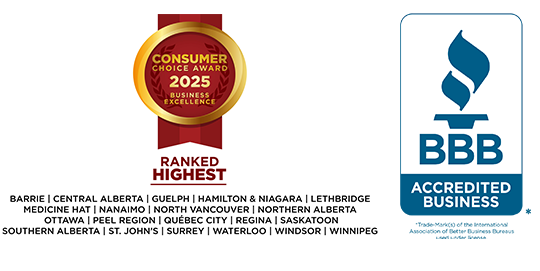While many European and South American countries offer free or significantly subsidized post-secondary schooling, costs have been steadily rising in Canada and can be prohibitive for many households. Much depends on where and what you study, along with your plans to either live at home or move to another city.
A 2018 Maclean’s study found the average annual post-secondary education cost for those respondents living at home was $9,300. This spiked to approximately $20,000 for those who’ve moved away. Rent accounted for almost half the added cost, followed by tuition. About half of the students reported in debt by the end of their studies — at an average of $27,000 per student — with parents picking up much of the difference.
What are your options to help with these costs?
A good education and unmanageable debt can both have lasting consequences for students and parents alike. And many families struggle with deciding whether the future career and wage growth opportunities outweigh the years of monthly payments and interest charges. Thankfully, it doesn’t have to be an all or nothing proposition.
Here are some strategies financial experts advise to help pay for post-secondary schooling and reduce (and potentially eliminate) student debt.
Registered Education Savings Plan (RESP)
The RESP is a federally sponsored, tax-deferred savings vehicle which allows parents to save up to $4,000 per year for their children’s post-secondary education until they’re 18 years old (up to a total of $50,000). You have a variety of investment options within your RESP to help its tax-free growth. Talk to your financial advisor to find the right mix for your situation.
The key to maximizing the benefit of a RESP is to start early: Obtain a social insurance number for your children and open a plan as soon as possible. If grandparents wish to help with the future costs of post-secondary education, encourage them to help with contributions.
Canada Education Savings Grant (CESG)
The Federal Government also offers an additional 20 percent top up (up to $500) on anything you invest into the plan every year. This automatic return on your investment before any eligible investment growth, makes the RESP is one of the best ways to save for future costs without breaking the bank.
You can maximize the CESG by investing at least $2,500 per year into your child’s RESP. If you miss a year, eligibility for the grant also has a limited carryforward period.
Canada Learning Bond
Qualifying lower-income households may also take advantage of the Canada Learning bond to add an additional $100 per year to RESP contributions, along with a $500 grant when your child is born and $25 to cover the costs to open an RESP.
Part-time and seasonal work
Start talking to your children about their future plans, even before they finish primary school. They may not have a career path in mind, and that’s fine. But these conversations will flesh out whether further studies are likely and help them appreciate the related costs.
Once your children start working (often in high school) bring these conversations back into focus and encourage an active savings habit. Setting aside 10 percent of their income can make a huge dent in tuition and books — 20 percent is even better (they live at home after all) — and build a lifelong commitment to preparing for unexpected costs.
Working part time during their post-secondary studies may or may not be possible depending on course load and other commitments (athletics, etc.). However, many programs offer access to excellent paid internships, cooperative programs, and other employment opportunities during and after the school year.
Paying from family cashflow
If prior saving for post-secondary costs wasn’t possible, perhaps your current cashflow or savings allows you to help with your children’s education costs. Here just a few scenarios where this may be possible:
One-time or recurring financial gift
You can withdraw funds from your Tax Free Savings Account (TFSA) without penalty at any time. If you have the financial cushion, you may wish to provide a one-time or recurring gift to your children to cover tuition, books, or other post-secondary costs.
Interest-free education loan
You could also consider speaking with your children about loaning funds for their education, interest free — which is a good option if your TFSA is a necessary part of your retirement mix. They would still need to pay you back after they graduate, but the total cost would be significantly lower.
Sell assets or liquidate investments
You may also choose to sell auxiliary properties (vacation home, recreational vehicles, etc.) or stocks to free up the funds your child needs to attend post-secondary schooling. However, due to the significant tax liabilities involved, we do not recommend liquidating your RRSPs for this purpose.
Borrowing to pay the costs
For many, the options above are simply insufficient to cover the skyrocketing costs of post-secondary education. In these cases, federal and provincial student loan and grant funding may be available. The Government of Canada has the qualifying criteria and guidelines on its website.
Risks of government student loans
Be mindful that Bankruptcy and Consumer Proposal options will not be available to forgive your children’s student loans for the first seven years after they graduate. They will have to make arrangements with the relevant government agency if they’re unable to repay their student loans which may require significant personal and lifestyle sacrifices.
Risks of financing from private lenders
It’s also important to note that if you co-sign for a student line of credit (which may be forgivable if your child were to file a Bankruptcy or Consumer Proposal), you are fully liable for the full balance owing if they are no longer legally responsible for the debt or cannot pay it.
Risks of using your own credit vehicles
If you’re considering using your own available credit (credit cards, lines of credit, etc.) it’s imperative you consider your financial situation carefully. Some key questions to ask yourself include:
- How much debt do I / we already have outstanding?
- How much interest do I expect to pay on this added debt?
- How long do we expect to take to pay off this debt?
- What are my future income prospects like?
- Are there better alternatives?
Arguably, education is never a bad investment. But it can be a bad debt if it significantly impacts your standard of living and potentially jeopardizes your own retirement and lifestyle goals.
Start early and save often
Get your children to start thinking about their future and speak with them frequently about how you can help them reach their goals together. Virtually all their choices have an associated cost, the key to minimizing them is to begin saving early and creating numerous paths to reduce their impacts along the way.


